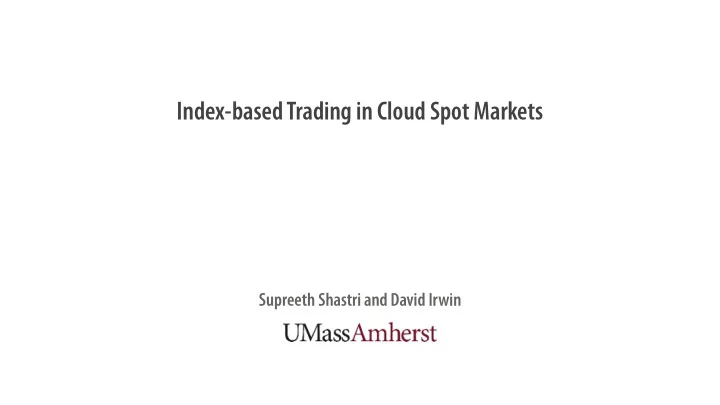

Index-based Trading in Cloud Spot Markets Supreeth Shastri and David Irwin
Idle Cloud is Provider’s Workshop 76 * 8 10-50 % Hardware types Contracts IaaS is evolving into a marketplace typical utilization in large datacenters On-demand, Reserved (1 or 3), Spot, Spot-block, [ 2013 ] The Datacenter as a Computer: An Introduction Burstable, Dedicated or Shared to the Design of Warehouse-Scale Machines. 2/15
g n i l Idle Cloud Capacity l e S Spot Markets Users bid in a EC2 continually evaluates supply- Allocate: bid price ≥ spot price 2nd price auction demand to price spot servers Revoke: bid price < spot price ❝ On average, AWS customers are using more compute capacity on spot instances than across all of EC2 in 2012 ❞ https://aws.amazon.com/10year/ 3/15
Spot Price Prediction Research SIGCOMM 2015 HotCloud 2016 Bid-level HPC 2016 IC2E 2016 ICDCS 2016 ICPE 2017 SIGMETRICS 2017 Characterized by spikes that are hard to predict Startups ➡ Reduces disruptive revocations SpotInst Accurate Prediction ➡ Helps compare different servers Batchly ClusterK 4/15
Accurately Predicting Spot Prices is Difficult � 7600 + = 2 2-5 14 2 68 Regions Time Hardware Zones OS worldwide markets commitments config (datacenters) types (country, state) Limited correlation One size fits all model No visibility into with external variables is unlikely market internals 5/15
for CLOUD Market-based Index Rather than focusing exclusively on predicting individual servers, cloud users should make decisions, in part, based on broader market indices 6/15 Image credit: www.cnbc.com/mad-money/
Market-based Index for CLOUD Characterizing a group of servers Characterizing an individual server i Price = P i Average of normalized prices Memory = M i GB Compute = C i ECUs N norm Σ P i P i norm = i=1 P i Index-level = √ ( C i * M i ) N 7/15
Market Indices at Global Level On-demand Spot Markets Compute-time is 50% more expensive Worldwide spot market is remarkably stable in Brazil than Canada with ~80% discount from on-demand avg 8/15
Indices at Different Market Granularities Global Regional ⤾ Individual Zonal Price prediction is easier and more accurate at higher market-level than individual server level 9/15
can benefit from Server Trading Flexible Applications ๏ Spot Markets prices are dynamic ๏ Many price inversions exist No geographical Scalable ๏ Provider always “ buys ” back servers Containerized constraints … but Trading incurs Transaction Cost Memory state and disk migration, Unused server time, Fault-tolerance overhead 10/15
Choosing the Best Server E [ R i - R free ] R i = Asset’s return Sharpe ratio = R free = Risk free return σ i σ i = Std. deviation of returns Chooses the server that has not only low price but also low volatility 11/15
Scope of Server Trading in EC2 Region Availability zone 12/15 World map: https://commons.wikimedia.org/wiki/File:BlankMap-World_gray.svg
Server Trading Policies Policy Server Choice Trading Trading Cost Market-based Globally best server No 0 No Trading Market-based Globally best server Within the zone Fixed (120s) Local Trading Market-based Globally best server Anywhere globally Proportional (1-4m/GB) Global Trading Index-based Globally best zone, Within the zone Fixed (120s) Global Trading then locally best server 13/15
Evaluation 14/15
To Conclude… Spot price prediction is an active research topic Prior works have focused on individual servers, we introduce market-based indices Flexible applications can trade servers We demonstrate trading based on market-based achieve best cost-performance tradeoff Future work Defining application-specific indices Using indices for benchmarking spot-based systems 15/15
Thank you! Supreeth Shastri shastri@umass.edu
Recommend
More recommend